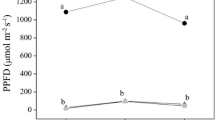Summary
The photosynthetic capacity and carbon metabolism of the fruits of Isomeris arborea (Capparidaceae), an evergreen shrub endemic to the desert and coastal habitats of Southern California and Baja California, are described. The inflated structure of the pods of I. arborea provides a model system for experimental studies of fruit photosynthesis in native plants since the gas concentration of the internal space can be manipulated and monitored separately from the external pod environment. CO2 released by seed respiration is partially contained in the inner gas space of the pods, resulting in an elevated CO2 environment inside the fruit (500 to 4000 μmol mol−1 depending on the stage of fruit development). A portion of this CO2 is assimilated by the inner layers of the pericarp, but a larger fraction leaks out. The photosynthetic layers of the pericarp use two different sources of CO2: the exocarp fixes exogenous CO2 while the endocarp fixes CO2 released by seed respiration into the pod cavity. Even though the total weight of the fruit increases during development, the combined rates of fixation of externally and internally supplied CO2 remained constant (10–11 μmol CO2 pod−1 h−1). After the pods attain maximum volume, the major change in gas exchange that takes place during fruit growth is a gradual increase in the amount of respiratory CO2 released by the seeds. This shifts the CO2 balance of the fruit from positive, in young fruits, to negative in mature fruits. Pericarp photosynthesis helped support not only the cost of fruit maintenance, but also the cost of fruit growth, particularly during the first stages of fruit development. During later fruiting stages insufficient carbon is fixed to fully supply either respiration or growth.
Similar content being viewed by others
References
Andrews AK, Svec LV (1975) Photosynthetic activity of soybean pods at different growth stages compared to leaves. Can J Plant Sci 55:501–505
Atkins CA, Pate JS (1977), An IRGA technique to measure CO2 content of small volumes of gas from the internal atmospheres of plant organs. Photosynthetica 11:214–216
Atkins CA, Kuo J, Pate JS, Flinn AM, Steele TW (1977) Photosynthetic pod wall of pea (Pisum sativum L.): Distribution of carbon dioxide-fixing enzymes in relation to pod structure. Plant Physiol 60:779–786
Bazzaz FA, Carlson RW, Harper JL (1979) Contribution to reproductive effort by photosynthesis of flowers and fruits. Nature 279:554–555
Caemmerer S von, Farquhar D (1981) Some relationships between the biochemistry of photosynthesis and the gas exchange of leaves. Planta 153:643–653
Field CB, Berry JA, Mooney HA (1982) A portable system for measuring carbon dioxide and water vapor exchange of leaves. Plant Cell Environ 5:179–186
Flinn AM, Atkins CA, Pate JS (1977) Significance of photosynthetic and respiratory exchanges in the carbon economy of the developing pea fruit. Plant Physiol 60:412–418
Janzen DH (1982) Physiological ecology of fruits and their seeds. In: Lange OL, Nobel PS, Osmond B, Ziegler H (eds) Physiological plant ecology II. (Encyclopedia in Plant Physiology, NS, vol 12C). Springer, Berlin Heidelberg New York, pp 325–378
Jones HG (1981) Carbon dioxide exchange of developing apple (Malus pumila Mill.) fruits. J Exp Bot 32:1203–1210
Lighton JRB, Bartholomew GA (1988) Standard energy metabolism of a desert harvester ant, Pogonomyrmex rugosus: Effects of temperature, body mass, group size, and humidity. Proc Natl Acad Sci USA 85:4765–4769
Long SP, Hallgren J-E (1985) Measurement of CO2 assimilation by plants in the field and the laboratory. In: Coombs J, Hall DO, Long SP, Scurlock JMO (eds) Techniques in Bioproductivity and Photosynthesis. Pergamon Press. Oxford New York Toronto Sydney Frankfurt, pp 62–94
Nobel PS (1983) Biophysical Plant Physiology and Ecology. Freeman WH and Co, San Francisco p 608
Osmond CB, Smith SD, Gui-Ying B, Sharkey TD (1987) Stem photosynthesis in a desert ephemeral, Eriogonum inflatum. Characterization of the leaf and stem CO2 fixation and H2O vapor exchange under controlled conditions.Oecologia 72:542–549
Quebedeaux B, Chollet R(1975) Growth and development of soybean [Glycine max (L.) Merr.] pods. CO2 exchange and enzyme studies. Plant Physiol 55:745–748
Reekie EG, Bazzaz FA (1987) Reproductive effort in plants. I. Carbon allocation to reproduction. Am Nat 129:876–896
Sambo EY, Moorby J, Milthorpe FL (1977) Photosynthesis and respiration of developing soybean pods. Aust J Plant Physiol 4:713–721
Tobiessen PL (1970) Temperature and drought stress adaptation of desert and coastal populations ofIsomeris arborea. Ph.D. dissertation, Duke University pp 141
van der Pijl L (1972) Principles of dispersal in higher plants. Springer, Berlin Heidelberg New York
Willson MF (1983) Plant Reproductive Ecology. Wiley and Sons, New York
Author information
Authors and Affiliations
Rights and permissions
About this article
Cite this article
Goldstein, G., Sharifi, M.R., Kohorn, L.U. et al. Photosynthesis by inflated pods of a desert shrub, Isomeris arborea . Oecologia 85, 396–402 (1991). https://doi.org/10.1007/BF00320616
Received:
Accepted:
Issue Date:
DOI: https://doi.org/10.1007/BF00320616




